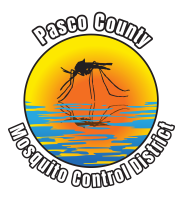Aquatic Herbicide
The PCMCD’s Aquatic Herbicide program, does not perform herbicide applications to control aquatic weeds for beautification purposes. Staff focus control efforts targeting invasive, non-native weeds that harbor certain mosquito species, or to thin out areas such as floating plant mats where growth is so thick that natural mosquito predators like minnows can’t access the immature mosquitoes.

Aquatic herbicide equipment includes herbicide trucks with a hose reel, airboats, amphibious vessels, and helicopters. The increased development of residential housing in formerly unpopulated areas of the District results in a continuously increasing aquatic weed control effort.

Airboats are a key component in treating adult mosquito populations, particularly in large or challenging aquatic environments such as marshes, swamps, and floodplains. These boats are equipped with specialized spray systems that allow for the effective application of insecticides over extensive water surfaces and vegetation where mosquitoes breed. The unique design of airboats, with their shallow draft and powerful propellers, enables them to navigate through shallow and obstructed waters where traditional boats cannot reach. By using airboats, mosquito control efforts can cover large areas efficiently, applying herbicides to target mosquito larvae and reduce their populations in critical habitats.
Amphibious machines are versatile all-terrain vehicles used to treat adult mosquitoes in rugged or uneven landscapes. The spray system disperses insecticide in a fine mist, allowing for effective mosquito control in challenging environments. Technicians also use the watercraft to perform aquatic weed control, which ultimately contributes to mosquito control.
The district’s primary efforts include the control of two exotic floating weeds: Water Hyacinth (Eichornia crassipes) and Water Lettuce (Pistia stratiodes). These plants support the development of Mansonia dyari and Mansonia titilans mosquito species. A third mosquito, Coquilletidia perturbans, is also associated with aquatic weeds. It is found on a number of types of rooted plants along the edges of lakes, ponds, canals, and ditches but is best known to be associated with Cattails.
We only attempt to control plants that harbor certain mosquito species, or to thin out areas such as floating plant mats where growth is so thick that natural predators can’t access the mosquito larvae and pupae.Life is like riding a bicycle. To keep your balance, you must keep moving.
